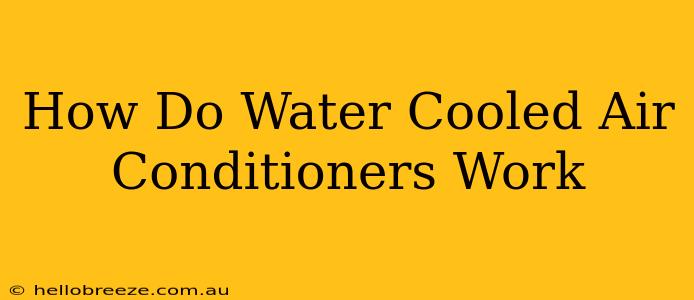Water-cooled air conditioners offer a powerful and efficient cooling solution, especially in situations where removing heat is challenging. Unlike air-cooled systems that release heat into the surrounding air, water-cooled units transfer heat to a continuous water supply, significantly improving efficiency and reducing environmental impact. This comprehensive guide will delve into the inner workings of these systems.
Understanding the Fundamentals: How Refrigeration Works
Before diving into the specifics of water-cooled ACs, it's crucial to grasp the basic refrigeration cycle. This cycle, common to all air conditioners, involves four key stages:
- Evaporation: A refrigerant, a special fluid with low boiling point, absorbs heat from the indoor air, turning into a gas.
- Compression: A compressor increases the pressure and temperature of the refrigerant gas.
- Condensation: The high-pressure, high-temperature refrigerant gas releases its heat to a condenser. This is where the key difference between air-cooled and water-cooled systems lies.
- Expansion: The refrigerant expands through an expansion valve, lowering its pressure and temperature, preparing it for the next evaporation cycle.
The Water-Cooled Advantage: Efficient Heat Removal
The crucial difference lies in how the condenser dissipates heat. In air-cooled systems, the condenser releases heat directly into the surrounding air via a heat exchanger with fins. In contrast, water-cooled systems use water as a coolant. The high-temperature refrigerant gas in the condenser transfers its heat to the continuously flowing water. This water then carries away the heat to a cooling tower or other heat rejection system, resulting in:
- Higher efficiency: Water is significantly more efficient at absorbing heat than air. This translates to lower energy consumption and a smaller carbon footprint.
- Improved performance in hot climates: Air-cooled systems struggle in extremely hot and humid conditions, as their cooling capacity diminishes. Water-cooled systems maintain consistent performance even in intense heat.
- Reduced noise: Water-cooled systems are typically quieter than their air-cooled counterparts, especially large-capacity units.
Components of a Water-Cooled Air Conditioner
A typical water-cooled air conditioning system includes several key components:
- Refrigeration Unit: This houses the compressor, condenser, evaporator, and expansion valve – the heart of the refrigeration cycle.
- Condenser Water Pump: This circulates water through the condenser, constantly removing the heat absorbed from the refrigerant.
- Cooling Tower: This is a crucial component for larger systems. It evaporates a portion of the water, using the latent heat of vaporization to dissipate heat into the atmosphere. Smaller systems may use a chiller or other heat rejection method.
- Water Treatment System: This is often included to prevent mineral buildup and corrosion within the system, ensuring its longevity and efficient operation.
- Indoor Air Handling Unit: This distributes the cooled air throughout the conditioned space.
Applications of Water-Cooled Air Conditioners
Water-cooled air conditioners are ideal for a variety of situations where efficient cooling and heat rejection are paramount:
- Large commercial buildings: High-rise office buildings, shopping malls, and industrial facilities often utilize water-cooled systems due to their high cooling capacity and efficiency.
- Data centers: Maintaining optimal temperatures for servers requires high-capacity cooling systems; water-cooled solutions excel in this area.
- Industrial processes: Certain manufacturing processes generate significant heat and benefit from water-cooled air conditioning.
- Hospitals and laboratories: Precise temperature control is critical; water-cooled units provide the necessary stability.
Choosing the Right System: Factors to Consider
Selecting the appropriate water-cooled air conditioning system involves careful consideration of several factors:
- Cooling load: Accurate calculation of the cooling requirements for the space.
- Water availability: Sufficient water supply and proper water treatment are essential.
- Environmental regulations: Compliance with local environmental regulations regarding water usage and heat dissipation.
- Budget: The initial investment and ongoing operational costs must be factored into the decision.
Conclusion: A Powerful Cooling Solution
Water-cooled air conditioners represent a sophisticated and highly effective cooling technology. Their superior efficiency, consistent performance, and reduced noise make them a preferred choice for various applications where reliable and powerful cooling is crucial. Understanding the principles behind their operation can help you make informed decisions about cooling solutions for your needs.

